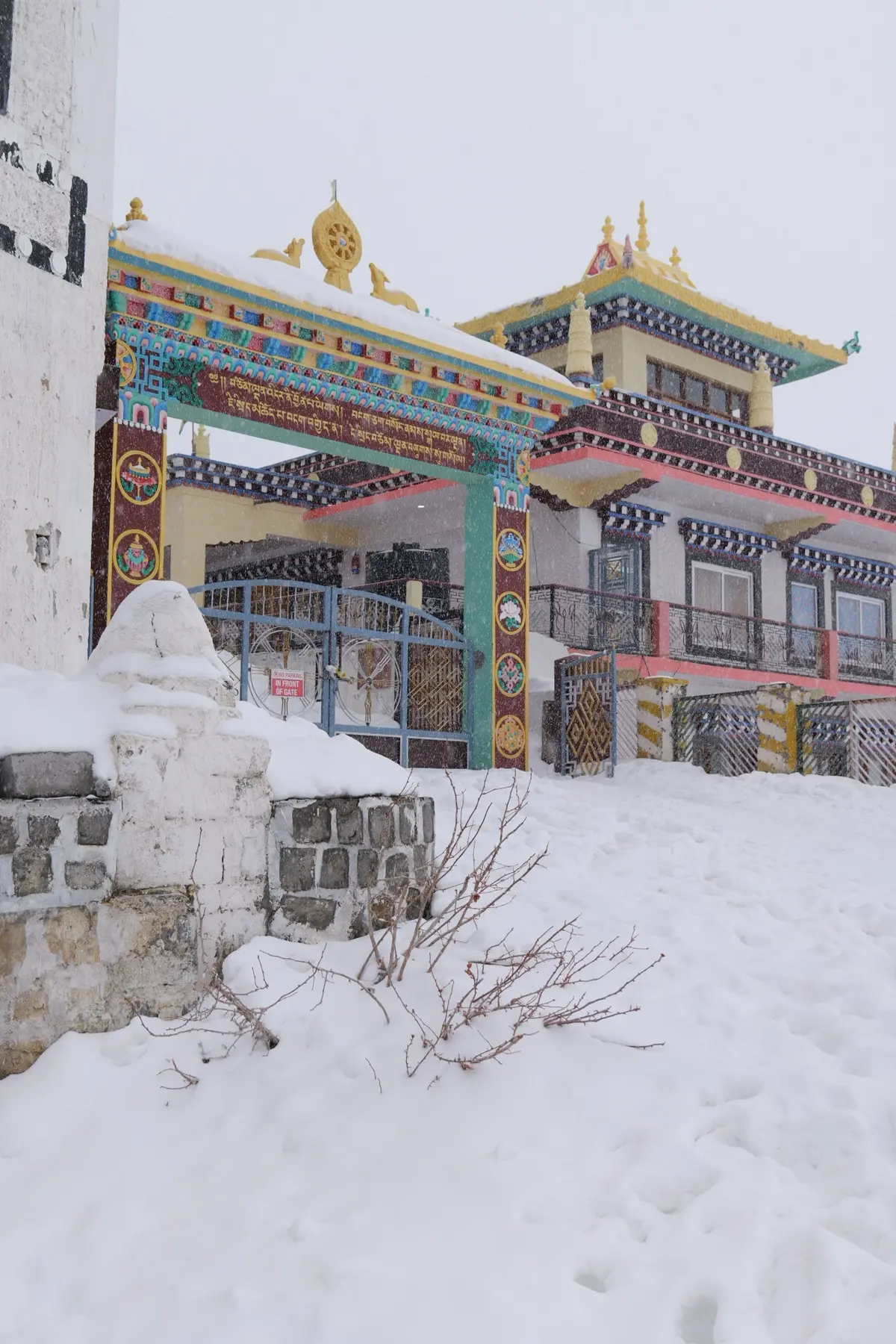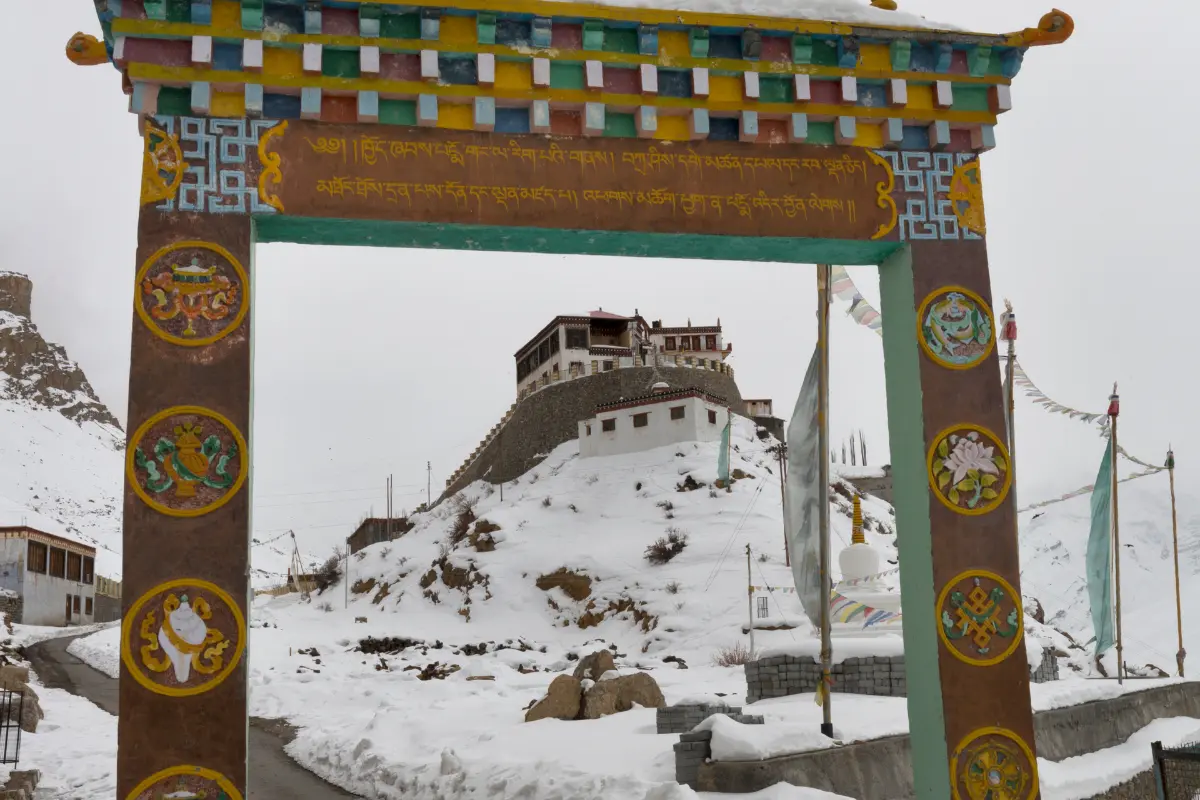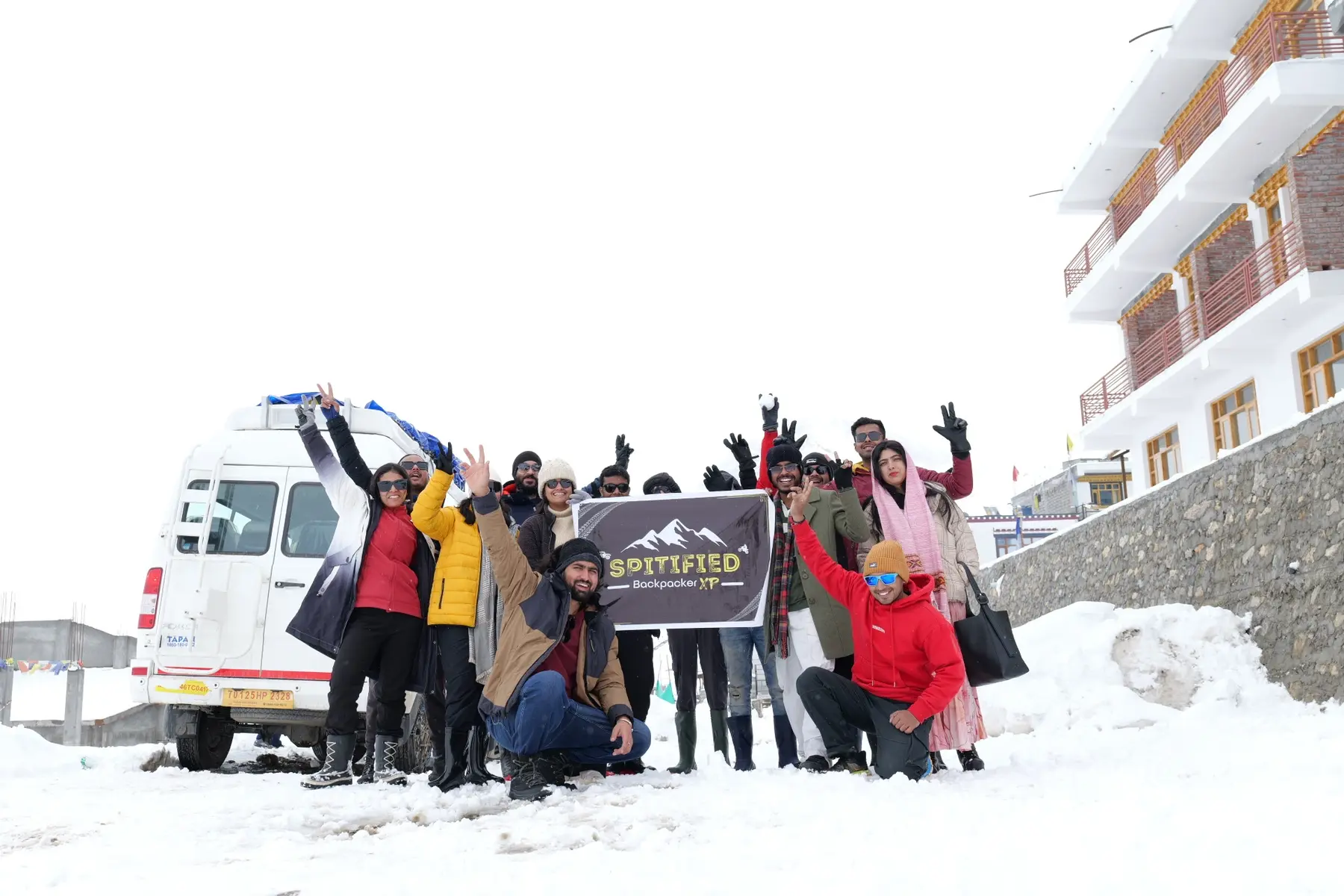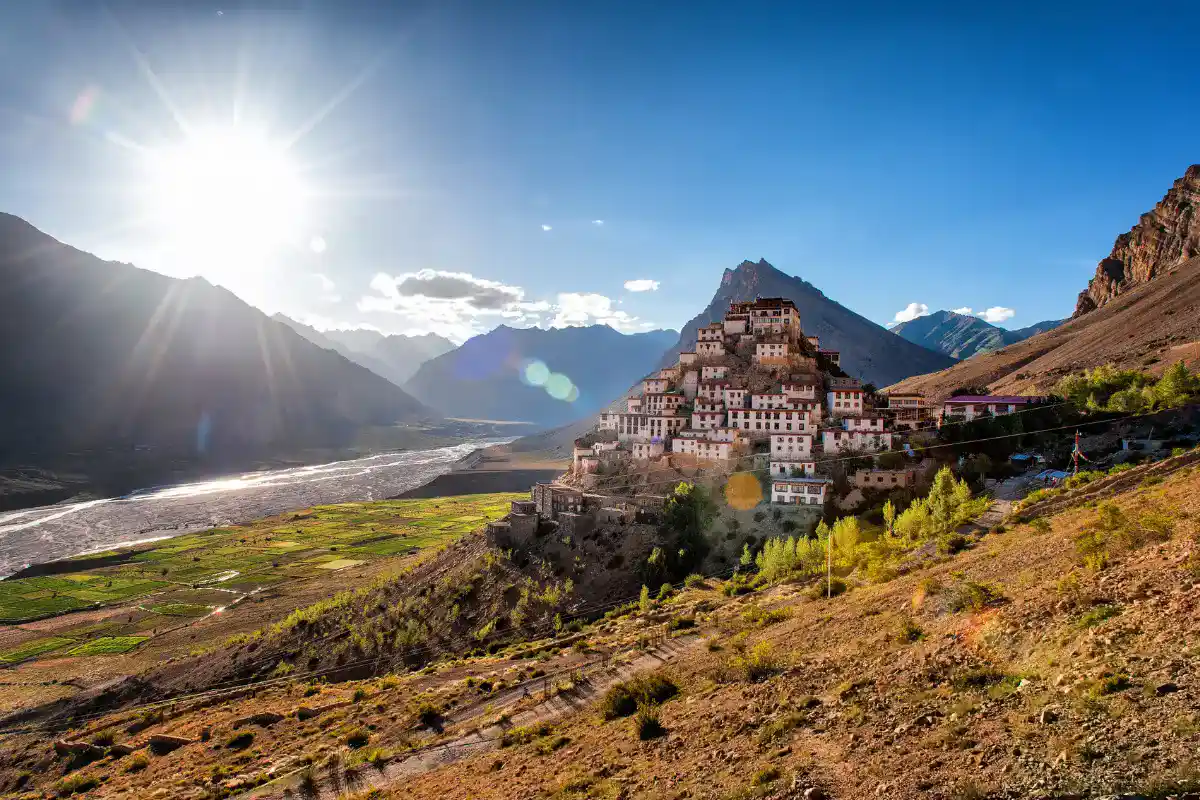Explore Key Monastery, Spiti Valley’s ancient spiritual fortress. Discover its history, monk life, how to reach, and breathtaking Himalayan views. Plan your authentic Spiti adventure!
1. Welcome to Key Monastery: Where Time Stands Still in Spiti’s Embrace
A High-Altitude Haven for the Soul: Why Key Gompa Calls to Every Backpacker
Spiti Valley is a raw, high-altitude desert landscape unlike anywhere else in India. And perched dramatically on a craggy hilltop, overlooking this stark beauty, sits Key Monastery – or Kye Gompa. For backpackers seeking a blend of adventure, spirituality, and cultural immersion, Key Monastery is a magnet.
What Makes This Ancient Monastery a Must-Visit in Spiti Valley
Why should you include Key Monastery in your Spiti itinerary? Because it’s more than just a pretty picture. It’s a living, breathing monument to Tibetan Buddhism, a place where you can witness ancient traditions, connect with monks, and find a sense of peace amidst the rugged Himalayas. This travel guide will give you everything you need to plan your visit.
2. Key Monastery: A Glimpse into Spiti’s Spiritual Soul
Over a Millennium of History: Tracing the Roots of Kye Gompa
Founded in the 11th Century: A Legacy of Resilience
Key Monastery’s story is one of survival. Founded in the 11th century, legend says the monastery was built on a hill resembling a mythological bird called Garuda. It has weathered countless storms – invasions, earthquakes, even fires – yet it stands tall.
Gelugpa Sect’s Stronghold: Understanding its Spiritual Significance
The monastery is a stronghold of the Gelugpa sect of Tibetan Buddhism, also known as the Yellow Hat sect. This lineage emphasizes monastic discipline and philosophical study. As per locals, Key Monastery is also known as the “Monastery at the Center of the Mandala,” highlighting its spiritual significance.
Architecture That Defies Gravity: The Fortress-Like Marvel of Key Monastery
Multi-tiered, Organic Design: Built for Survival and Serenity
What makes Key Monastery so visually striking? Its architecture. It’s not just one building, but a cluster of structures clinging to the hillside, like a fortress sculpted from the rock itself.
This multi-tiered, organic design isn’t just for show. It was built to withstand the harsh climate and historical invasions. According to keymonasteryspiti.org, the monastery is known as the “Monastery at the Center of the Mandala”
Whitewashed Walls & Red Accents: A Landmark Against the Barren Landscape
The whitewashed walls and red accents of the monastery create a stark contrast against the barren landscape, making it a truly unforgettable sight. The design is an interesting blend of Indian and Tibetan styles.
Living at 13,668 Feet: Life at Key Monastery’s Extreme Altitude
Key Monastery sits at a staggering altitude of 13,668 feet (4,166 meters). Life here is about adapting to the thin air, the harsh winters, and the simple rhythms of monastic life.
Visiting the monastery provides a glimpse into this unique way of living, where spirituality and resilience go hand in hand. The monastery is also home to the revered reincarnations of Lochen Rinchen Zangpo, also known as the “Great Translator” (958-1055 AD).
3. The Best Time to Immerse Yourself at Key Monastery
Summer (May – October): Spiti Valley’s Open Arms
Pleasant Days & Accessible Roads: Your Gateway to Adventure
Summer is the sweet spot for visiting Spiti Valley and Key Monastery. The roads are generally open, the weather is pleasant, and the landscape is at its most inviting. It is a popular time to experience monastic life and Spiti Valley culture.
Temperature Check: What to Expect from 10°C to 25°C
During these months, you can expect temperatures ranging from 10°C to 25°C. Pack layers, as the evenings can still be chilly. As per the Himachal Tourism website, summer is the peak season in Spiti.
Winter (Late October – April): A Snow-Covered Spiritual Wonderland
Braving the Cold: Temperatures Below -20°C & Harsh Conditions
Winter in Spiti is a different beast altogether. Temperatures plummet, often dipping below -20°C. The landscape transforms into a snow-covered wonderland, but the conditions are harsh.
The Challenge of Snow-Blocked Roads: Is Winter Travel for You?
Many roads become impassable due to heavy snowfall. If you’re an experienced winter traveler seeking solitude and a truly unique experience, winter in Spiti might be for you, but be prepared.
Monsoon (August): A Time to Be Mindful
Landslide Risks & Slippery Roads: Why Caution is Key
The monsoon season, particularly August, brings its own set of challenges. Landslides are a real risk, and roads can become slippery and dangerous.
4. How to Reach Key Monastery: Your Spiti Valley Expedition
Your Gateway: Kaza, Spiti Valley’s Hub
Kaza is your basecamp for exploring Key Monastery and the surrounding Spiti Valley. Most travelers reach Kaza first, then make their way to the monastery.
Getting to Kaza: The Epic Road Journeys
The Manali Route (Seasonal: June-October): Adventure Through Atal Tunnel & Kunzum Pass
The Manali route is the more adventurous option, taking you through the Atal Tunnel and over the Kunzum Pass. This route is generally open from June to October, depending on snow conditions.
Road Conditions & Travel Time: What to Expect
The road conditions can be challenging, with rough patches and high mountain passes. Expect a travel time of around 10-12 hours from Manali to Kaza.
Permits for Rohtang Pass (If Applicable)
Check permit requirements for Rohtang Pass, if applicable, before you travel. These permits are often required for vehicles crossing the pass. But usually the vehicles pass through the Atal Tunnel, bypassing the Rohtang Pass.
The Shimla Route (Mostly Year-Round): Kinnaur Valley’s Scenic Drive
The Shimla route is the longer but more reliable option, as it remains mostly open year-round. This route takes you through the scenic Kinnaur Valley.
A Longer, Gradual Acclimatization
One advantage of the Shimla route is the gradual acclimatization to the altitude, as you ascend more slowly than on the Manali route.
Road Conditions & Overnight Halts
Road conditions are generally good, though there may be some rough patches. Plan for an overnight halt in a place like Reckong Peo.
From Kaza to Key Monastery: The Final Stretch (14-15 km)
Local Taxis & Shared Cabs: Quick & Convenient
From Kaza, the Key Monastery is only about 14-15 km away. Local taxis and shared cabs are readily available and offer a quick and convenient way to reach the monastery.
Renting a Bike: Your Own Two-Wheeled Adventure
For the adventurous, renting a bike in Kaza is a popular option. The ride to Key Monastery is scenic and rewarding.
The Kibber-Bound Bus: A Local Experience
A local bus bound for Kibber passes by Key Monastery. This is a budget-friendly option and a chance to experience local transport.
Hitchhiking: Spiti’s Friendly Vibe
Hitchhiking is also a common and relatively safe option in Spiti Valley, thanks to the friendly locals and tourist traffic.
Nearest Airports & Railway Stations: Planning Your Connections
Bhuntar Airport (KUU), Kullu: Your Closest Flight
The nearest airport is Bhuntar Airport (KUU) near Kullu, but flights can be infrequent. From Bhuntar, you’ll need to take a taxi or bus to Kaza.
Shimla & Chandigarh: Broader Connectivity
Shimla and Chandigarh offer broader flight connectivity. From either city, you can take a bus or hire a taxi to Kaza.
Shimla Railway Station is the closest railway, approximately 445 km from Kaza.
5. Things to Do at Key Monastery: Beyond the Postcard Views

Explore the Labyrinthine Architecture: Wander Through History’s Halls
Main Assembly Hall (Dukhang): Murals, Thangkas & Ancient Chants
Step inside the main assembly hall (Dukhang) and prepare to be transported. Murals depicting Buddhist deities and scenes from the Buddha’s life adorn the walls. The air is thick with the scent of incense and the echoes of ancient chants.
Library of Sacred Texts: Uncovering Buddhist Wisdom
The monastery’s library houses a vast collection of sacred texts, offering a glimpse into Buddhist philosophy and wisdom. You will see rare manuscripts in Bhoti and Tibetan scripts.
Collection of Ancient Artifacts: Weapons, Buddha Idols & Relics
Explore the collection of ancient artifacts, including weapons, Buddha idols, and religious relics. These objects tell the story of the monastery’s past and its enduring spiritual significance.
Dalai Lama’s Apartment: A Glimpse of Reverence
On the uppermost floor, discover the apartment reserved for His Holiness, the Dalai Lama. It is a symbol of respect and reverence.
Witness Monastic Life Up Close: A Day with the Lamas
Morning & Evening Prayers: A Truly Meditative Experience
Participate in the morning and evening prayers for a truly meditative experience. You’ll have a glimpse into the daily life of the monks.
Conversations with Monks: Insights into Buddhist Philosophy
Engage in conversations with the monks to gain insights into Buddhist philosophy and their way of life. The Monks are very friendly and you can learn a lot.
Trying Yak Butter Tea: A Local Warmth Ritual
Don’t miss the chance to try yak butter tea, a local staple that provides warmth and sustenance in the high altitude. It is a truly unique experience.
Capture the Grandeur: Photography Tips for Stunning Panoramas
Sunrise & Sunset Views: The Monastery Bathed in Golden Light
For photographers, Key Monastery is a dream. Capture the monastery bathed in the golden light of sunrise or sunset for truly stunning panoramas.
Bird’s-Eye View: The Short Hike Behind the Gompa
Take a short hike behind the gompa for a bird’s-eye view of the monastery and the surrounding landscape. It’s a great way to gain a new perspective.
Experience Vibrant Festivals: The Ki Cham Dance & More
Chaam Dance (Tsechu Festival): Masked Monks & Symbolic Rituals (June/July)
If you’re lucky enough to be there during the Tsechu festival (usually in June or July), witness the Chaam Dance, a mesmerizing display of masked monks and symbolic rituals. The Chaam dance is believed to have originated from Guru Padmasambhava’s rituals to fight spirits while building a monastery.
Kalachakra Ceremony: Seeking Enlightenment
The Kalachakra ceremony, often performed by the Dalai Lama, is a complex initiation believed to liberate participants from suffering.
Yenne Gaaye (Khetal) Celebration: Blessings for Villages
The Yenne Gaaye (Khetal) celebration involves monks visiting and blessing homes in nearby villages. They protect them from evil spirits.
6. Local Culture & Authentic Spitian Life Around Key Gompa
Greeting with “Julley”: A Word for Everything
Learn to greet locals with “Julley,” a versatile word that means hello, goodbye, thank you, and more.
Spitian Hospitality: Homestays & Community Living
Experience the warmth of Spitian hospitality by staying in homestays and participating in community living. Spitians are very welcoming and very helpful.
The Rhythm of Monk Life: Education, Sports & Daily Chores
Observe the rhythm of monk life, which includes education, sports, and daily chores. You will see young lamas engaging in various sports.
Resilience of the Spitian People: Adapting to High-Altitude Living
Witness the resilience of the Spitian people, who have adapted to the challenges of high-altitude living. The monastery provides a secular and religious education to its monks up to the tenth grade, followed by advanced Buddhist teachings.
7. Stay & Food Options Near Key Monastery
Staying at Key Monastery: A Deep Dive into Monastic Life
Basic Dormitory Accommodation: Simple, Spiritual, and Budget-Friendly
For a truly immersive experience, consider staying at Key Monastery itself. Basic dormitory accommodation is available, offering a simple, spiritual, and budget-friendly option.
Monastery Homestay: Upgraded Comforts (If Available)
The monastery also has the facility of a homestay. It offers basic comforts. In this case, you will need to contact the monastery well in advance.
Meals with Monks: Dal-Rice, Tsampa & Butter Tea
Share meals with the monks, typically consisting of dal-rice, tsampa (roasted barley flour), and butter tea. This will be a completely authentic experience.
Accommodation in Kaza: Your Base Camp for Spiti Exploration
Guesthouses, Hotels & Homestays: Options for Every Backpacker
Kaza offers a wider range of accommodation options, including guesthouses, hotels, and homestays, catering to every type of backpacker. These homestays, often built in traditional mud-and-stone architectural styles designed to retain warmth, are run by friendly local families who provide home-cooked Spitian meals and can arrange local experiences like stargazing and trekking.
Local Delicacies to Savor: Beyond the Monastery Walls
Thukpa, Momos & Tingmos: Tibetan Flavors of Spiti
Venture beyond the monastery walls to savor local delicacies like thukpa (noodle soup), momos (dumplings), and tingmos (steamed buns), all showcasing the Tibetan flavors of Spiti.
Yak Cheese (Chhurpi): A High-Altitude Specialty
Don’t leave without trying yak cheese (chhurpi), a high-altitude specialty that’s both delicious and nutritious. Yak cheese, or “chhurpi” (from female yaks called chhuru), is also used in dishes like Quo, made with cubed barley flour, potatoes, and yak cheese.
8. Essential Tips for Your Key Monastery Adventure

Acclimatization is Key: Don’t Skip Your Stay in Kaza
Acclimatization is paramount. Spend at least a day or two in Kaza to allow your body to adjust to the high altitude before visiting Key Monastery.
Dress Code & Etiquette: Respecting Sacred Spaces
Modest Clothing: Cover Shoulders and Knees
When visiting Key Monastery, dress modestly, covering your shoulders and knees. This shows respect for the sacred space.
Silence in Prayer Halls: Be Present, Not Disruptive
Maintain silence in the prayer halls and be mindful of your surroundings. Be present, not disruptive.
Photography Rules: Ask Before You Click
Always ask for permission before taking photos, especially of monks or during prayer sessions.
Packing Smart for Spiti Valley: From Layers to Essentials
Warm Clothing: Even in Summer, Nights are Chilly
Pack warm clothing, even if you’re visiting in summer, as the nights can be surprisingly chilly.
Sun Protection & Hydration: High Altitude Must-Haves
Sun protection (sunscreen, sunglasses, hat) and hydration are essential at high altitude. Drink plenty of water.
Cash & Connectivity: Be Prepared for Limited Access
Carry sufficient cash, as ATMs are scarce and often unreliable. Be prepared for limited connectivity, as mobile networks can be spotty.
Health & Safety: Altitude Sickness, Medication & Emergency Contacts
Be aware of the signs of altitude sickness and take necessary precautions. Carry any necessary medication and keep emergency contacts handy.
9. Exploring Beyond Key Monastery: Nearby Villages & Wonders
Kibber Village (9 km): One of the World’s Highest Inhabited Villages
Visit Kibber Village, one of the world’s highest inhabited villages, located just 9 km from Key Monastery.
Chicham Bridge (12 km): Asia’s Highest Suspension Bridge — An Adrenaline Rush!
Experience the thrill of crossing Chicham Bridge, Asia’s highest suspension bridge, located 12 km from the monastery.
Langza Village (16 km): The Fossil Village & Giant Buddha Statue
Explore Langza Village, known as the Fossil Village, and marvel at the giant Buddha statue overlooking the valley, located 16 km away.
Komic Village (21 km): Highest Motorable Village & Tangyud Monastery
Venture to Komic Village, the highest motorable village in the world, and visit Tangyud Monastery, located 21 km from Key Monastery.
Dhankar Monastery (40 km): Perched on a Cliff, Overlooking River Confluence
Visit Dhankar Monastery, perched dramatically on a cliff overlooking the confluence of the Spiti and Pin rivers, located 40 km away.
Tabo Monastery (50 km): The “Ajanta of the Himalayas” & UNESCO Candidate
Explore Tabo Monastery, known as the “Ajanta of the Himalayas,” a UNESCO World Heritage Site candidate, located 50 km from Key Monastery.
Spiti Valley (2025) – Travel Guide, Places to visit, Best Time, How to Reach
10. Weather & Road Conditions: Navigating Spiti’s Untamed Beauty
Seasonal Road Accessibility: Manali vs. Shimla Routes
Be mindful of the seasonal road accessibility. The Manali route is typically open from June to October, while the Shimla route remains mostly open year-round.
Impact of Climate Change: Water Scarcity & Erratic Weather
Understand the impact of climate change, which is leading to water scarcity and erratic weather patterns in Spiti Valley.
Staying Safe: Landslides, Snowfall & Cloudbursts
Stay informed about potential hazards like landslides, snowfall, and cloudbursts, and take necessary precautions.
11. Why Visit Key Monastery with BackpackerXP

Curated Adventures, Authentic Experiences: More Than Just a Trip
BackpackerXP offers curated adventures and authentic experiences that go beyond just a trip. We are here to give you an immersive experience.
Responsible Travel: Exploring Spiti Sustainably
We are committed to responsible travel, ensuring that we explore Spiti sustainably and minimize our impact on the environment.
Connect with the Local Soul: Immersive Journeys, Not Just Sightseeing
Our journeys are designed to connect you with the local soul, offering immersive experiences rather than just sightseeing.
Hassle-Free Exploration: We Handle the Logistics, You Chase the Horizon
We handle all the logistics, allowing you to focus on chasing the horizon and enjoying your Spiti Valley adventure.
12. FAQs About Key Monastery
What is the best time to visit Key Monastery?
The best time to visit Key Monastery is from May to October when the weather is pleasant and the roads are accessible.
How far is Key Monastery from Kaza?
Key Monastery is approximately 14-15 kilometers from Kaza.
Can visitors stay at Key Monastery?
Yes, visitors can stay at Key Monastery. You have to get in touch with the monastery well in advance. The monastery also has the facility of a homestay. It offers basic comforts.
Is there an entry fee for Key Monastery?
There is no entry fee for Key Monastery. However, donations are welcome and appreciated.
What are the opening hours of Key Monastery?
Key Monastery typically has visiting hours from 7 AM to 7 PM.
What kind of food is available at Key Monastery?
The monastery serves simple vegetarian meals like dal-rice, tsampa, and butter tea. (Remember this is for pre-approved Monastery guests)
What should I wear when visiting Key Monastery?
Dress modestly, covering your shoulders and knees, to show respect for the sacred space.
Is photography allowed inside Key Monastery?
Photography inside prayer halls may be restricted, so ask for permission before taking photos.
Are there ATMs or mobile networks near Key Monastery?
ATMs are scarce and often unreliable, so carry sufficient cash. Mobile networks can be spotty. BSNL and Reliance Jio 4G work in the area.
What is the significance of the Chaam Dance?
The Chaam Dance is a masked dance performed during the Tsechu festival, symbolizing the triumph of good over evil.
Final Thoughts
Key Monastery is more than just a destination; it’s an experience that stays with you long after you’ve left. The raw beauty of Spiti Valley, combined with the spiritual aura of the monastery, creates a truly unforgettable journey. Whether you’re seeking adventure, cultural immersion, or simply a sense of peace, Key Monastery offers something for everyone.
Planning a trip to Key Monastery? Message us on WhatsApp at +91 8005729115 to join our next BackpackerXP experience.



0 Comment